Clinical observation on tuina plus foot bath with Chinese medicine for diabetic foot in early stage
Xu Cheng-hua (许成华), Wu Yun (吴云), Yu Nian-tang (俞年塘), Lu Jing (鲁静)
1 Tonglu TCM Hospital, Zhejiang Province, Hangzhou 311500, China
2 Anhui University of Chinese Medicine, Hefei 230038, China
Abstract Objective: To observe the clinical effect of tuina plus foot bath with Chinese medicine for patients with diabetic foot (DF)in early stage.
Keywords: Tuina; Massage; Diabetes Mellitus; Diabetes Complications; Diabetic Foot; Traditional Chinese Drugs;Steaming Washing Therapy
Diabetes is a common disease. Recently, an epidemiological survey showed that the incidence rate of diabetes in Chinese adults was as high as 9.7%, with a higher incidence rate in the senior population. It's estimated that 20.4% of the people over 60 years old suffered from diabetes[1]. Severe complications such as foot ulcer and gangrene occurred to 15%-20% diabetes patients[2]. Grade 0 diabetic foot (DF) is an early stage of DF, in which symptoms might be reversed. Therefore,it's a crucial period for the treatment. We have observed the clinical effect of tuina plus foot bath with Chinese medicine for DF patients in early stage,and compared it with a control group. The report is now given as follows.
1 Clinical Materials
1.1 Diagnostic criteria
1.1.1 Diagnostic criteria of diabetes
Referring to the diagnostic criteria of diabetes of American Diabetes Association (ADA) in 2014 (type 2 diabetes)[3]: symptoms of diabetes with blood glucose≥11.1 mmol/L (200 mg/dL) at any time, or fasting blood-glucose (FBG) ≥7.0 mmol/L (126 mg/dL) (the definition of fasting is no caloric intake within 8 h), or 2 h serum glucagon ≥11.1 mmol/L (200 mg/dL) in oral glucose tolerance test.
1.1.2 Diagnosis criteria of early-stage DF
Referring to the Inspection Methods and Diagnosis Criteria for DF (limb gangrene) (protocol) by Diabetes Group, Chinese Medical Association[4]and Wagner grading scale[5]. Grade 0: with risk factors of ulcer in foot,without ulcer at present time; grade 1: superfacial ulcer,without infection; grade 2: deeper layer ulcer, usually combined with soft tissue infection, without abscess or bone infection; grade 3: deep infection, with bone tissue impairment or abscess; grade 4: bounded gangrene (toe, heel or front dorsal foot area); grade 5:gangrene over the whole foot.
With symptoms of DF in early stage: skin itching on both feet, weakened dorsalis pedis artery pulse,numbness, cold or stabbing pain in foot. We chose grade 0 in Wagner grading scale of DF as the definition for the early-stage DF.
1.2 Inclusion criteria
Conformed to the diagnosis criteria above;voluntarily participated with informed consent.
1.3 Exclusion criteria
Didn't conform to the diagnosis criteria or inclusion criteria above; failed to conform to the treatment scheme; unable to judge the clinical efficacy or incomplete clinical materials.
1.4 Statistical methods
All data were processed by the SPSS version 17.0 software. The measurement data were described as mean ± standard deviation (±s), independent t-test was used for inter-group comparison, and pairedsample t-test was used for intra-group comparison. The enumeration data were analyzed by Chi-square test. A P value less than 0.05 indicated statistical significance.
1.5 General data
A total of 70 patients with early-stage DF were included in our hospital between July 2017 and December 2017. The patients were divided into a treatment group and a control group by the random number table, with 35 cases in each group. During the treatment, 5 cases dropped out in the treatment group versus 1 case in the control group. There were no significant differences in gender, age and disease duration between the two groups (all P>0.05),indicating the comparability (Table 1).

Table 1. Comparison of general data
2 Treatment Methods
2.1 Control group
Patients in the control group received conventional medication and nursing care. The conventional treatment included insulin injection or oral administration of hypoglycemic agents, as well as diabetes-related health education, in which advices for patients' daily diet and exercise, regulation strategy of blood glucose, lipid and blood pressure were detailed.Patients also received a daily foot nursing care. The treatment was given once a day, 14 d as a course. There was a 2-day interval between 2 courses. Therapeutic efficacy was evaluated after 2 courses of treatment.
2.2 Treatment group
Patients in the treatment group received foot bath with Chinese medicine plus tuina on the basis of the treatment given in the control group.
2.2.1 Foot bath with Chinese medicine
Herbs: Hong Hua (Flos Carthami) 15 g, Ru Xiang(Olibanum) 30 g, Mo Yao (Myrrha) 30 g, Dan Shen(Radix Salviae Miltiorrhizae) 30 g, Ding Xiang (Flos Syzygii Aromatici) 9 g, Ji Xue Teng (Caulis Spatholobi)30 g, Du Huo (Radix Angelicae Pubescentis) 30 g and Niu Xi (Radix Cyathulae) 30 g.
Method: Applied foot bath with Chinese medicine once a day. Boiled the herbs with 2 000 mL water, the water temperature should be around 38-41℃ and also the bathing water should reach the patient's ankle level,30 min every time.
Attention: Gave instructions before foot bath.Conducted foot bath in avoidance of the rush-hour during transfusion and lunch time. Discharged before the foot bath, with windows and doors closed. Covered patients' knees with towel in winter time to avoid catching cold. Wiped both feet and lower limbs immediately after the foot bath and kept their feet warm.
2.2.2 Tuina
Patients took a supine position after foot bath with Chinese medicine. Smeared moisturizer on patient's feet and legs. First, Cuo-twisted the patient's feet and legs from the bottom up and created a warm feeling on their feet. Then Rou-kneaded the plantar reflex zone with the index finger joint (reflex zones including kidney,ureter and bladder) for 5 min (Figure 1); Rou-kneaded pancreas and blood glucose metabolism zone (medial center of tibia on both sides) with the thumb for 5 min(Figure 2 and Figure 3); An-pressed reflex zones of the heart, lung, liver, spleen separately with the thumb for 50 times on each point (Figure 1); An-pressed acupoints including Zusanli (ST 36), Sanyinjiao (SP 6), Yongquan(KI 1), Taixi (KI 3), Yanglingquan (GB 34), Yinlingquan(SP 9) and Jiexi (ST 41) separately with the thumb for 50 times on each point (Figure 4-Figure 10); Roukneaded the plantar reflex zone with the index finger joint (reflex zones including kidney, ureter and bladder)for 5 min (Figure 1).

Figure 1. The left plantar reflex zones

Figure 2. Rou-kneading pancreas reflex zone with the thumb

Figure 3. Rou-kneading blood glucose reflex zone with the thumb

Figure 4. An-pressing Zusanli (ST 36) with the thumb
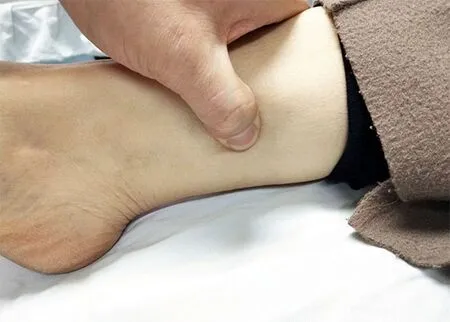
Figure 5. An-pressing Sanyinjiao (SP 6) with the thumb

Figure 6. An-pressing Yongquan (KI 1) with the thumb
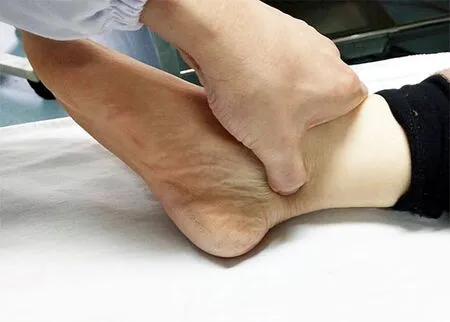
Figure 7. An-pressing Taixi (KI 3) with the thumb
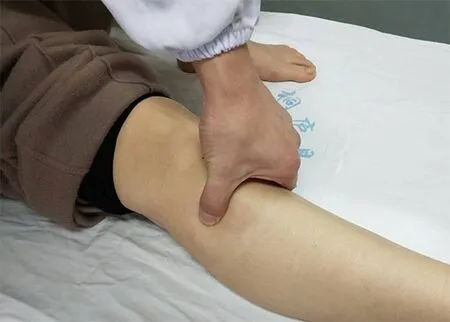
Figure 8. An-pressing Yanglingquan (GB 34) with the thumb
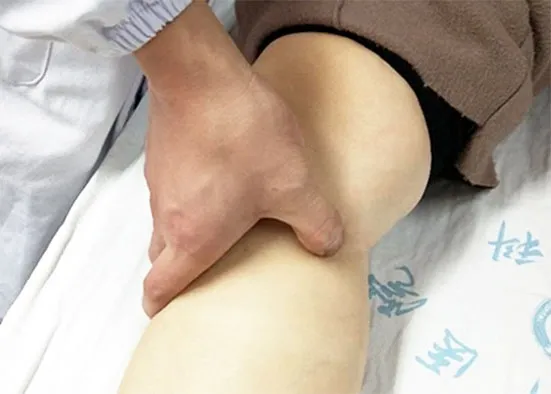
Figure 9. An-pressing Yinlingquan (SP 9) with the thumb
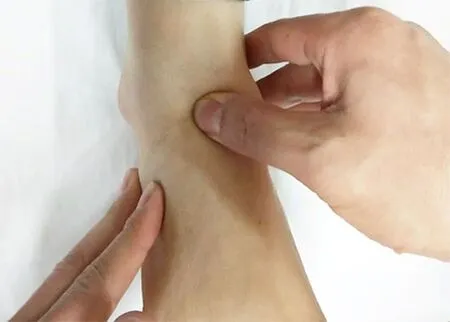
Figure 10. An-pressing Jiexi (ST 41) with the thumb
2.2.3 Attention
Tuina manipulation was done from the bottom up;avoided heavy manipulations. Applied a mild steady manipulation to cause only a slight pain in patients.
2.2.4 Course
Took foot bath with Chinese medicine and tuina twice a day, 14 d as a course, with a 2-day interval between 2 courses. The treatment was applied for 2 courses.
3 Therapeutic Efficacy Observation
3.1 Observation items
Ankle-brachial index (ABI): ABI was observed by the nurses from Diabetes Department with the patient taking a supine position. Measured the blood pressure on bilateral forearms and the systolic pressure was counted as the brachial pressure. Then measured the highest systolic pressure among the three ankle arteries(including anterior tibial artery, posterior tibial artery and peroneal artery) and the dorsal pedal artery and counted it as the ankle systolic pressure. Then divided ankle systolic pressure with brachial pressure and the value was counted as ABI.
Normal ABI value ranges between 0.90 and 1.30;0.70-0.89 indicates mild ischemia; 0.40-0.69 indicates moderate ischemia; ABI<0.40 indicates severe ischemia.
3.2 Therapeutic efficacy criteria
This was based on the Guiding Principles for Clinical Study of New Chinese Medicines[6]together with patients' clinical symptoms including skin itching on both feet, weakened dorsal pedal artery pulse and feelings of cold, numbness and stabbing pain on foot and the ABI value.
Recovery: Absence of clinical signs and symptoms,with the ABI value in a normal range.
Marked effect: Remarkable alleviation of clinical signs and symptoms, with the ABI value ranging from 0.70 to 0.89.
Improvement: Alleviated clinical signs and symptoms,with the ABI value ranging from 0.40 to 0.69.
Failure: No obvious improvement in clinical signs and symptoms, with the ABI value below 0.40.
3.3 Results
3.3.1 Comparison of therapeutic efficacy
After 2 courses of treatment, the recovery rate was 83.3% in the treatment group versus 29.4% in the control group; and the total effective rate was 96.7% in the treatment group versus 76.5% in the control group.The between-group differences in the recovery rate and total effective rate were all statistically significant (both P<0.05). It indicated a better therapeutic effect in the treatment group (Table 2).

Table 2. Comparison of the clinical efficacy (case)
3.3.2 Comparison of ABI
There was no significant between-group difference in ABI before treatment (P>0.05). After the treatment, the ABI values were significantly increased in both groups,and the intra-group and inter-group differences were significant (all P<0.05), (Table 3).
Table 3. Comparison of ABI (±s)

Table 3. Comparison of ABI (±s)
Note: Intra-group comparison, 1) P<0.05; compared with control group after the treatment, 2) P<0.05
Group n Pre-treatment Post-treatment Treatment 30 0.63±0.15 0.95±0.261)2)Control 34 0.64±0.16 0.76±0.231)
4 Discussion
Diabetes is a common chronic disease with a group of metabolic disorders. It has been regarded as an incurable disease with a long course. DF is a lower-limb disorder induced by diabetic vessel and nerve lesions.Traditional Chinese medicine (TCM) has a long history for the treatment of DF. Current scholars hold that early-stage DF fell under the category of Bi-impediment syndrome[7]. We hold that contributing factors of earlystage diabetes include qi (yang) deficiency and stasis blocking meridians, and it pertains to cold Biimpediment syndrome[8].
Current Western medicine treatment for DF includes medication, intervention, stem cell transplantation,artery by-pass operation, amputation and so on.Though such treatments can produce certain clinical efficacy for DF, the incidence of adverse events is not rare. Whereas TCM has many advantages in the treatment of early-stage DF patients. Yuan J[9]treated diabetic patients with comprehensive nursing care, the result showed that the incidence rate of diabetic complications was 11.1% in the treatment group versus 21.1% in the control group, and the between-group difference was statistically significant. Qi J, et al[10]treated early-stage DF patients with moxibustion along meridian on the basis of comprehensive treatment scheme. After 6 weeks of treatment, the DF symptom score, ABI and dorsal pedal artery ultrasonic hemodynamic index all showed significant improvements in the treatment group, and the improvements were better than those in the control group. Hua Y, et al[11]treated early-stage DF patients with herbal steaming and washing method plus tuina,and compared it with a control group (with medication for improving micro-circulation and nerve nourishment).The result showed that the recovery rate in the treatment group was 89.7% versus 57.5% in the control group, and the between-group comparison showed statistical significance. Li Y, et al[12]divided early-stage DF patients into two groups, and both groups received conventional Western medicine treatment, with foot care. Patients in the treatment group were additionally given herbal steaming and washing and infrared irradiation treatment on the affected foot, while those in the control group were additionally given warm water steaming and washing for foot. One course of treatment lasted for 15 d. After 1 course, the result showed a better effect in the herbal steaming and washing and infrared irradiation treatment group compared with the control group. Niu XW, et al[13]divided early-stage DF patients into two groups, and both groups received conventional Western medicine treatment. Patients in the treatment group were additionally given self-organized Luo Tong decoction plus acupuncture treatment. The total effective rate was 88.6% in the treatment group, versus 78.6% in the control group, and the between-group comparison showed statistical significance. Wang J, et al[14]divided DF patients into 2 groups, and patients in both groups received an in-hospital symptoms evaluation test before treatment. Patients in the control group received conventional methods plus DF prevention education,while patients in the treatment group received daily moxibustion at bilateral Sanyinjiao (SP 6). Patients'clinical symptoms alleviated or disappeared in the treatment group, indicating a significant therapeutic effect. He XF, et al[15]treated early-stage DF patients with foot bath with Chinese medicine. After 4 weeks(1 course) of treatment, the effective rate was 90.0%.The result showed that foot bath with Chinese medicine can effectively improve cold, burning pain and numbness in local skin, which is a good relief for patients.
To take active intervention in early-stage DF patients for the prevention of foot ulceration is the best manifestation of preventive treatment of diseases in TCM[16-18]. TCM holds that the general pathogenesis of DF includes yin deficiency as the root cause. When yin deficiency affects yang and qi-blood stagnate, pain occurs. Herbal steaming and washing and foot bath with Chinese medicine are traditional treatment methods in TCM. They can stimulate acupoints and meridians through medicinal functions and heat, and also have the functions of improving circulation,accelerating blood flow, dredging meridians, nourishing nerves and correcting metabolism disorder, thus improving signs and symptoms in pedal nerves[19-20].Our department screened early-stage DF patients, and treated them with tuina plus foot bath with Chinese medicine. The results showed that such treatment had functions of improving clinical symptoms and pedal nerve conduction, accelerating local blood circulation,preventing and postponing DF progression, and improving patients' quality of life. Therefore, it is worth clinical popularization.
Conflict of Interest
The authors declared that there was no potential conflict of interest in this article.
Acknowledgments
This work was supported by 2017 Science and Technology Development Project of Hangzhou (2017年杭州市科技发展计划项目, No. 172160).
Statement of Informed Consent
Informed consent was obtained from all individual participants or their relatives in this study.
Received: 20 May 2018/Accepted: 19 June 2018
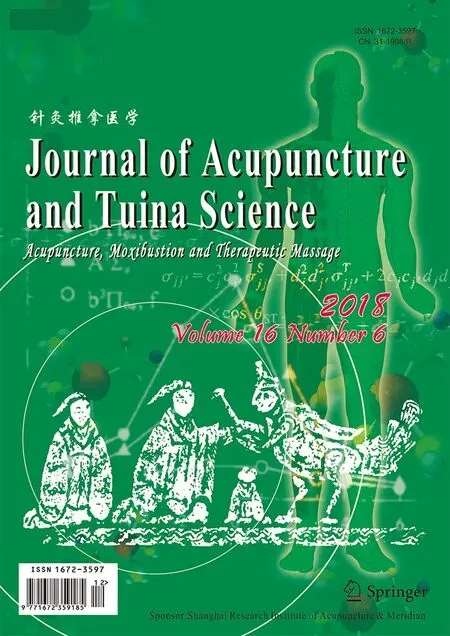 Journal of Acupuncture and Tuina Science2018年6期
Journal of Acupuncture and Tuina Science2018年6期
- Journal of Acupuncture and Tuina Science的其它文章
- Analysis of acupoint-selection patterns in acupuncture-moxibustion treatment of polycystic ovarian syndrome based on data mining
- Clinical observation of needling gluteus medius muscle trigger point plus chiropractic for sacroiliac joint subluxation
- Effect of tuina exercise on simple obesity in college students
- Therapeutic effect observation on acupuncture plus umbilicus application with Chinese medicine in treating detrusor underactivity
- Memory response to manual acupuncture in chronic insomniacs: evidence from event-related potentials
- Fire-needle therapy for deglutition disorders in post-stroke pseudobulbar palsy:a randomized controlled trial
